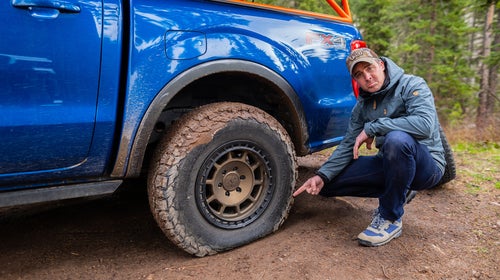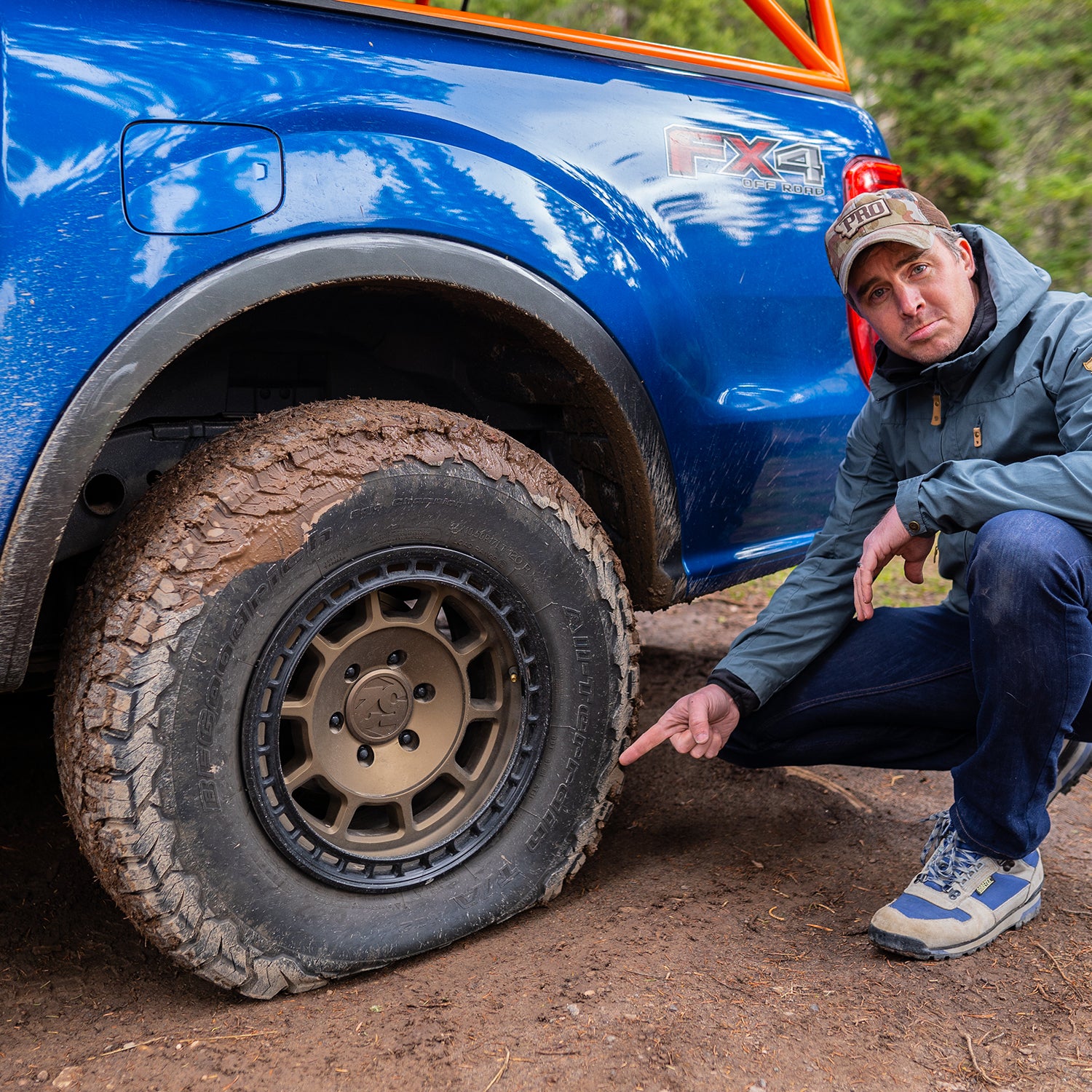Outdoor��enthusiasts are more subject than most to having to deal with a vehicle breakdown in a remote location��where��immediate help may not be available. Since tire punctures are by far the most common problem a vehicle will experience—and something��more likely to happen on dirt roads—and since you can’t always count��on your spare tire, it makes sense for us to arm ourselves with the tools and knowledge it takes to repair them ourselves.��Here’s how.
How Do You Know You’ve Got a��Puncture?��
On a paved road, if your steering wheel starts to wobble vaguely in your hands, or if you hear a loud thumping sound that coincides��with your wheels’ rotation, then you’ve got a flat tire. Off-road, at lower speeds, you’ll likely hear that thumping before you feel it. In both cases, avoid risking further damage to the tire or vehicle by finding the first safe location to pull off the road or trail.
Don’t Rely on��Your Spare
It’s become less and less common for new vehicles to come equipped with a full-size spare tire. Space savers, or donuts, are only designed to get you a very short distance��at very low speeds—across town to the tire shop, basically. You should avoid using a space saver on a dirt road or trail if at all possible.
And even if you have a full-size spare with a matching tire and wheel, it’s still possible to puncture more than one tire at a time. And man, that’s going to cause a big problem if you’re not prepared��or if it happens��somewhere you can’t easily call for help.
What You Need
The tools you should have to fix a flat tire��yourself don’t cost much more than getting a tire plugged at a tire shop. And they’re hundreds of dollars cheaper than calling for a tow. They’re also small��and light. There’s really no excuse for not carrying this stuff in your car or truck.
The best tire-repair kit I’ve found ��and costs $38. Like other kits, it includes rope plugs and the tools you need to install them, but this one goes above and beyond by including items like needle-nose��pliers, spare valve cores, and a folding razor blade.
You will also need a compressor. That’s what you’ll use to��reinflate your tire after you fix the puncture, or how you’ll air back up to road pressures if you’re airing down for off-road driving. If all you need is an emergency option,��. It plugs into your cigarette lighter (or 12-volt��outlet), so you don’t even need to open your hood.��You don’t want to rely on something like this if you’re regularly inflating oversize��off-road tires, but that’s a story for another time.
I also stick in every car my family owns, plus those of most of my friends. Fix-a-Flat includes both a sealant and compressed air in a single can, allowing you to take care of��the kind of small punctures caused by a screw or nail without even removing the wheel. And that capability makes it a unique tool in your arsenal—one that can come in handy for even complicated repairs where it’s not safe to to try and remove a wheel��or where gaining the ability to roll the car a few hundred yards can make the situation much safer (think: a steep slope off-road��or the side of a busy highway, with trucks rushing past just feet away).
Everyone should also carry . Use it to check the pressure of your tires��once a month, and adjust them to factory-recommended settings if they’re off. Ambient temperatures, elevation, and just time can all cause a tire to lose or gain pressure, and when it does so, it can harm your fuel economy, handling, and performance.
Avoid Trouble
Regularly inspect your tires��and replace them before the tread wears to 2/32nd��of an inch deep. An easy way to check this is to insert a penny upside down into the tread (Lincoln’s head first). If the tread reaches past Honest Abe’s hairline at his forehead, you’re good. If not, order new tires. Tires worn to or past 2/32nd��of an inch of tread will be much more prone to punctures��and won’t provide the same grip as a tire in good condition.
Tires also have a maximum life span of six years. To determine how old your tires are, look for the tire identification number on the sidewall: it��begins with DOT,��is 11 digits long, and ends in four numbers. The first two digits of those last four numbers represent the week (of 52 in a year) the tire was manufactured. The last two are the year.
If your tire shows any signs of cracking or��tearing, or if anything white or metallic has worn through the rubber, replace it immediately.
You also need to make sure you’re using an appropriate tire for the conditions you’re facing. If you’re traveling off pavement,��a quality all-terrain tire will help you avoid punctures both in the tread��and, more importantly, the sidewall.
Make sure any vehicle you’re driving has all of the necessary tire-change��tools present and accounted for. You’ll need a lug wrench��and a jack at a minimum. Don’t be that��person who��forgets to put them back into a��car. I even check for these things��in rental cars before driving off—they’re that essential.
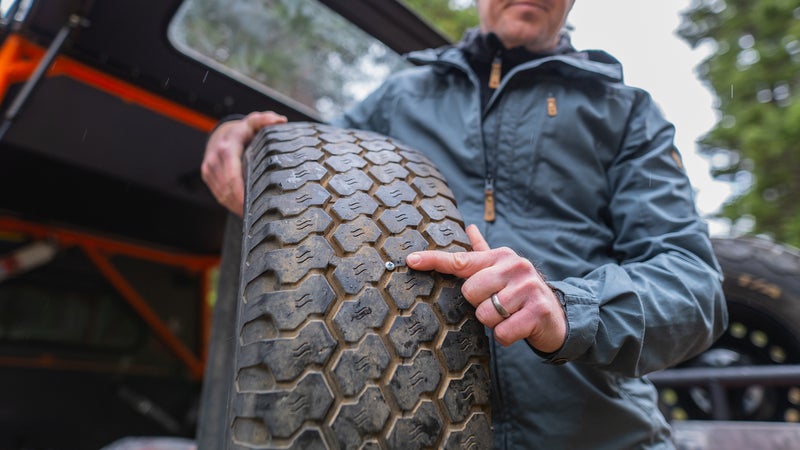
Step One: Find the Puncture
Once you’re in a safe place, hop out of the car, and find the flat tire. Try to��identify the source of the puncture. Sometimes��a foreign object will be very obvious at just a glance. Sometimes��you’ll need to roll the car a foot or two to expose the problem.
If you are able to see that there’s obviously a nail or screw embedded in your tire’s tread, that’s good news. If the nail or screw is strongly embedded into the tire’s tread, there’s no need to remove it at this time.��Get out your can of Fix-a-Flat, follow its��directions to connect��it to your tire valve, and empty the entire contents of the can into the tire. You should see the tire visibly inflate. If it returns to normal, drive off immediately, go a few miles, then stop and check your tire pressure, adjusting it if necessary. If the tire seems to be holding air, you’re good to continue driving, but take a look at the tire any time you stop. When you get back from your trip��and have the time, go ahead and follow the rest of the steps here to repair the puncture with a plug.
If you can’t find the source of the puncture,��if it’s an exposed hole, or if you don’t have a can of Fix-a-Flat, you’ll need to take the wheel off.
Step Two: Remove the Wheel
First, remove your spare (even if it’s a space saver), and place it under the frame of your vehicle��in front of the front tire or behind the rear tire. That way, if your vehicle falls off its jack, it will fall onto the spare, minimizing injury to you and damage to��the car.
Loosen the lug nuts��before you raise the vehicle. Remember: lefty loosey.
Next, follow the instructions in your owner’s manual to locate��and use the jack accordingly.
Once the wheel is off the ground, finish removing the lug nuts.��Put them somewhere safe. Pull the wheel out toward��your body. Be careful—wheels��can be heavy.
Step Three: Evaluate the Puncture
If you have a hole in your tread, it can be fixed. Tires in good condition won’t experience more than a simple hole in that location. If the hole is in your sidewall (the portion of the tire that rides roughly vertical), you just need to mount your spare��and have the tire replaced at the first possible opportunity.
If the hole is in the tire’s tread��and can’t be taken care of��by simply dumping a can of Fix-a-Flat into it, roll the tire��around to the back of your vehicle where tools are��and where you can safely work away from traffic. Look for holes and foreign objects as you roll it. If a hole is small and the tire is no longer leaking air, it may be a good idea to mark the hole for easy reference later.
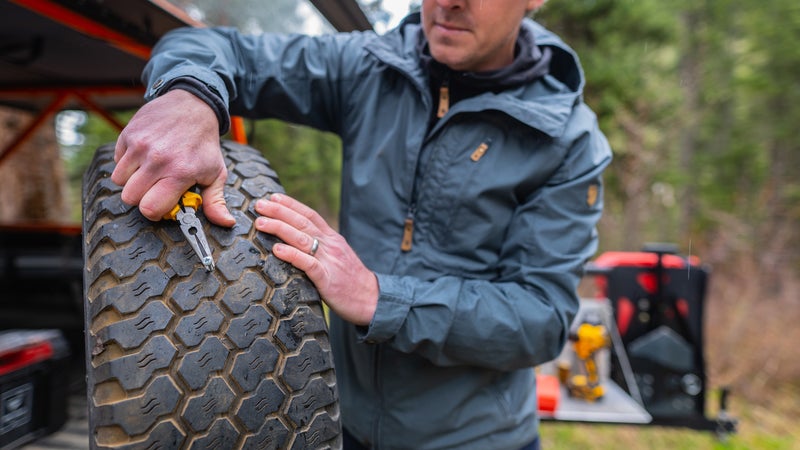
Step Four: Remove the Problem
If there’s a foreign object in your tire, and the tire can no longer hold air, remove it. In the video, I used a screw gun to put the screw in the tire, meaning its threads engaged with the rubber and steel belts. Most roads��don’t have their own screw guns, so the puncture won’t engage the threads in the same way, and it should be easier to pull out��using your needle-nose pliers.
I’ve seen tires punctured by everything from a steel bar��to a particularly nasty cactus barb. Organic objects like tree branches can leave residue behind. Try and get all of that out of the way.
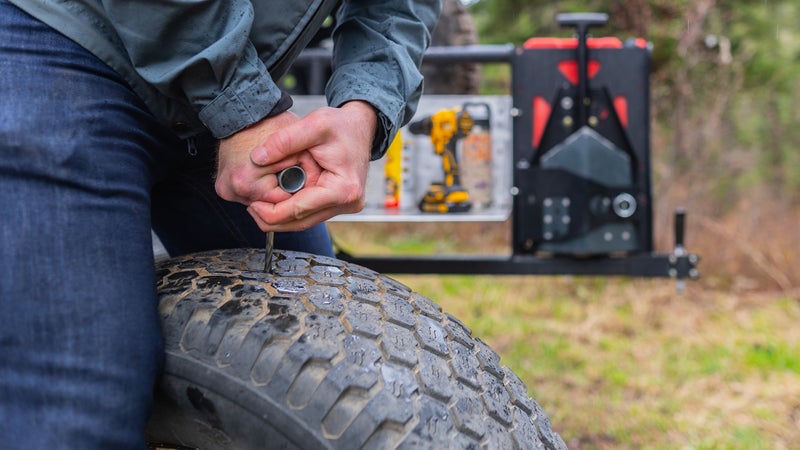
Step Five: Enlarge the Hole
If the hole is larger than a pencil, skip this step. If not, grab your tire-repair kit’s reamer, and use it to enlarge the hole until it is roughly the size of a pencil.
If you have a very small hole, this will be difficult at first.��Install the reaming tool by slowly screwing it into the tread while applying downward��pressure. Otherwise, just push the tool into the hole all the way up to the handle, then��yank it out. Repeat until the hole is large enough that you can insert and remove the tool without much effort.
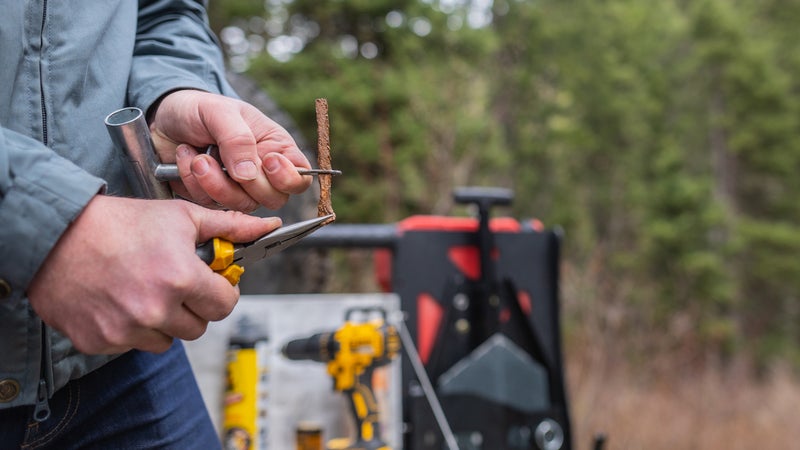
Step Seven: Install the Plug
Remove a rope plug from the plastic wrapper, flatten one end with the needle-nose pliers, and push it through the eyelet on the installation tool. Grasp the protruding edge of the plug with the pliers, and pull it through the eyelet until equal lengths of the plug protrude from both sides.
Grab a finger of lube from the kit, and apply it to the plug and leading edge of the tool.
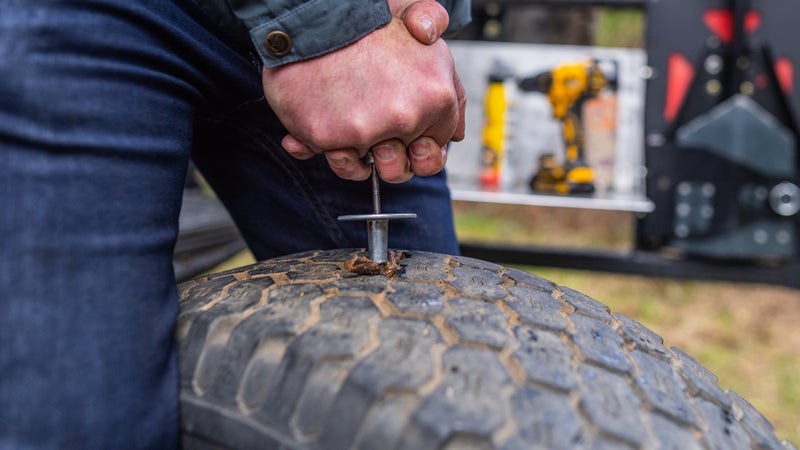
Place the tool tip down on top of the hole in the tire, grasp the tool securely with both hands, and force it through the tire until the depth guide is flush with the tread. Then��yank the tool straight out of the hole as hard and fast��as you can. The rope plug should pass through the eyelet��and remain inside the tire.
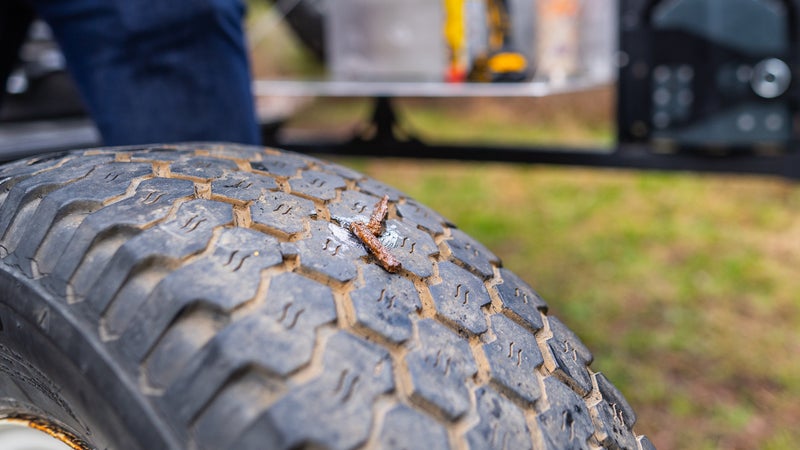
If you have only a small puncture, one plug should do. If not, you may need to install a second or third. If you must install multiple plugs, then plan on taking that tire to a shop the first possible opportunity, where it can be��evaluated��for safety. You may have to replace it. But most of the time, that single plug will be enough. Use the razor to trim the excess length flush with the tire tread.
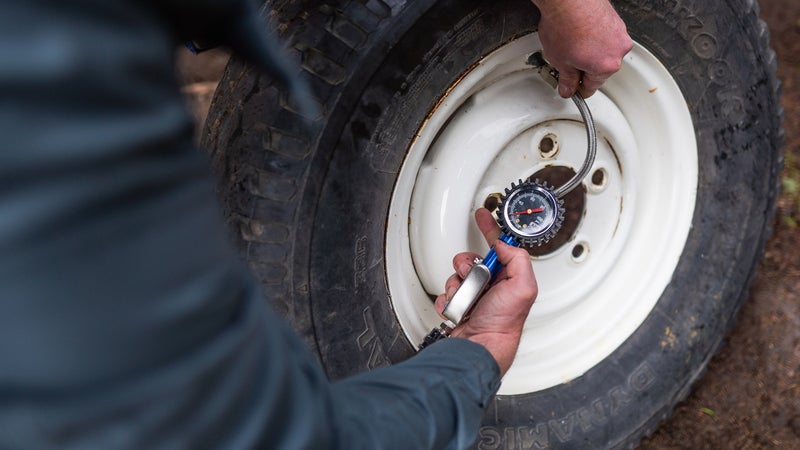
Step Eight: Reinstall the Wheel
Use your air compressor to inflate the tire to the recommended pressure. (You’ll find that listed inside the driver’s doorjamb.) Once inflated, reverse the tire-removal steps described above to reinstall the wheel. First, install the lug nuts by hand to secure the wheel to the hub.��Then, once you’ve lowered the vehicle back down and removed the jack, use the lug wrench to make sure all the lug nuts are as tight as possible. Tighten them in a star pattern, so the wheel snugs back to the hub evenly. Remember: righty tighty. Check these again later that day.
Return all your tools, the jack, and the lug wrench to their proper locations. You’d don’t want to misplace this stuff.
And that’s it. No tow truck. No hiking out a dirt road in search of help. No waiting on AAA while sitting on the side of a busy highway. No huge expense. And no more than a few minutes of hard work.
